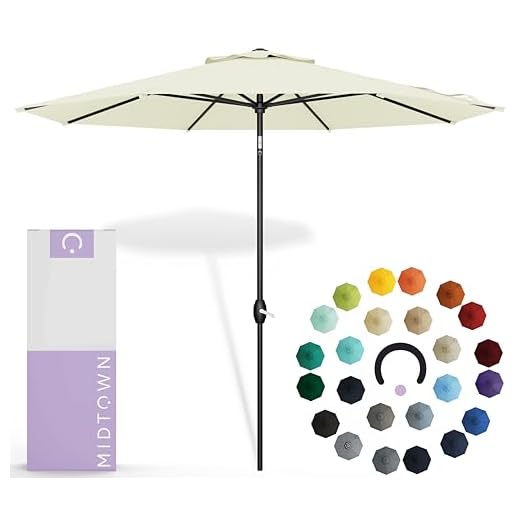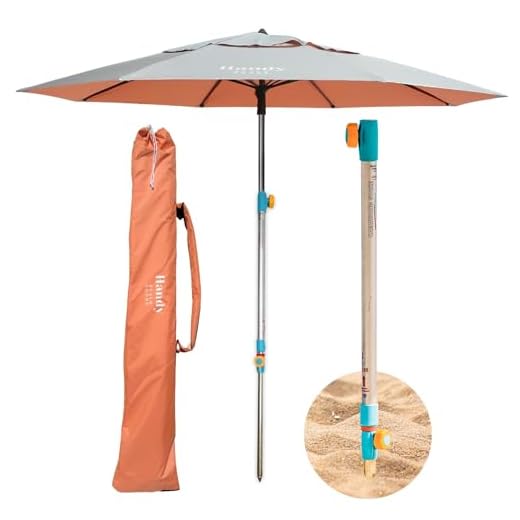



For optimal sun protection, select a cover made from solution-dyed acrylic or polyester. These materials provide excellent UV resistance and durability, ensuring your shade remains effective during hot summer days.
This article is designed for anyone looking to enhance their outdoor experience by understanding the best choices for their sun shelters. Whether you’re a frequent beachgoer, a picnic enthusiast, or simply enjoy lounging outdoors, knowing the right fabric can make all the difference in comfort and longevity.
In this piece, we will explore various fabrics, including their pros and cons, and offer tips for selecting the ideal option based on your lifestyle and preferences. You’ll find insights that will help you make an informed decision, ensuring you enjoy your time in the sun with peace of mind.
Optimal Fabric Choices for Sunshade
Polyester and acrylic are preferred options for a sunshade’s canopy due to their durability and UV resistance. Polyester is lightweight and dries quickly, making it convenient for beach outings. Acrylic, on the other hand, offers superior color retention and is less prone to fading in sunlight.
When considering the structure, aluminum and fiberglass are excellent choices. Aluminum frames are lightweight and resistant to rust, while fiberglass offers flexibility and strength, making it less likely to break in windy conditions. Both materials ensure stability and longevity for outdoor use.
Key Attributes of Canopy Fabrics
- UV Protection: Look for fabrics with high UV rating to shield from harmful rays.
- Water Resistance: Fabrics that repel water are advantageous for unexpected rain.
- Breathability: Well-ventilated materials prevent heat buildup underneath.
Additionally, consider the weight and portability of the sunshade. A lightweight design makes transportation easier, while a compact fold is beneficial for storage. The choice of fabric and frame should align with the intended usage and frequency of outings.
Conclusion
Evaluating these factors will lead to a practical selection for a sunshade that meets individual needs. Prioritizing durability and protection enhances the overall experience during outdoor activities.
Understanding UV Protection Levels
When selecting a sunshade, prioritize UV protection ratings. Fabrics are often treated to enhance their ability to block harmful rays, measured in UPF (Ultraviolet Protection Factor). A higher UPF indicates a greater level of protection. For instance, a material with a UPF of 50 can block approximately 98% of harmful UV radiation.
Consider the environment in which the shade will be used. Factors such as location, time of day, and weather conditions can affect UV exposure. Even on cloudy days, UV rays can penetrate clouds, making adequate protection necessary.
Factors Influencing UV Protection
Several elements contribute to the UV protection capabilities of a shade:
- Fabric Type: Dense weaves generally offer more protection.
- Color: Darker colors tend to absorb more UV radiation.
- Coatings: Special UV-blocking treatments enhance protection.
- Thickness: Thicker materials often provide better defense against UV rays.
Always look for products with clear UPF ratings. This information will guide you in choosing a suitable option that meets your sun protection needs.
Durability: Comparing Fabric Types
When selecting a canopy for outdoor use, the choice of fabric significantly impacts longevity and performance. Polyester and acrylic are two popular options, each offering distinct advantages and drawbacks.
Polyester is often favored for its affordability and lightweight properties. However, it tends to degrade faster under prolonged sun exposure, leading to fading and brittleness. On the other hand, acrylic provides superior UV resistance, ensuring that the color remains vibrant over time. This durability often justifies the higher cost associated with acrylic canopies.
Fabric Durability Comparison
| Fabric Type | UV Resistance | Water Resistance | Weight | Longevity |
|---|---|---|---|---|
| Polyester | Moderate | Good | Lightweight | 3-5 years |
| Acrylic | High | Excellent | Medium | 7-10 years |
Both fabric types can be treated with additional coatings to enhance their performance. For instance, a water-repellent finish can improve the water resistance of polyester, while UV-blocking treatments can extend the lifespan of polyester canopies. However, these treatments may require reapplication over time.
Ultimately, the choice between polyester and acrylic will depend on usage frequency and environmental conditions. Regular exposure to harsh sunlight and moisture may warrant an investment in the more durable acrylic option, while occasional use may suffice with polyester.
Lightweight Options for Easy Portability
Choosing a lightweight option for sun protection can significantly enhance your outdoor experience. Materials such as aluminum and fiberglass provide strength without unnecessary bulk, making it easy to carry your shelter to any destination.
Another consideration is the fabric used for the canopy. Polyester and nylon are popular choices due to their low weight and ability to resist fading from UV rays. These fabrics are often treated to improve water resistance, ensuring you stay dry during unexpected showers.
Benefits of Lightweight Structures
- Ease of Transport: Lightweight designs can be easily folded and packed, allowing for hassle-free travel.
- Quick Setup: Many lightweight models feature pop-up mechanisms that enable swift assembly, perfect for spontaneous outings.
- Compact Storage: Smaller sizes and lighter weights make them easier to store in limited spaces.
When selecting a portable shade solution, consider the balance between durability and weight. A well-constructed lightweight design can withstand wind while remaining easy to handle. Look for features such as reinforced seams and sturdy poles to enhance overall stability.
Finally, always check the weight specifications provided by manufacturers. Aim for options that maintain portability without sacrificing performance, ensuring your outdoor adventures are enjoyable and stress-free.
Water Resistance: Essential Features to Consider
Choosing a sunshade requires careful thought about its capacity to withstand moisture. Look for items crafted from synthetic fabrics treated to repel water, which can prevent water absorption and maintain structural integrity even during unexpected rain. A high-quality coating enhances the water-resistance level, ensuring the shield remains functional and dry.
Pay attention to seams and stitching techniques, as they play a significant role in preventing leaks. Flat-lock stitching or sealed seams can provide additional protection against water infiltration. It’s also wise to examine the canopy’s angle; a steep slope can help water run off, minimizing pooling and potential damage.
Additional Features to Enhance Water Resistance
- Fabric Type: Look for polyester or nylon blends that offer inherent water-repellent properties.
- Coatings: A polyurethane or silicone coating can significantly improve water resistance.
- Weight: Lighter materials often dry quicker but ensure they remain durable.
- UV Protection: Consider fabrics with UV-reflective properties to enhance durability against sun damage.
In summary, focus on the quality of fabric, seam construction, and design features to ensure optimal performance against moisture. These elements will contribute to a reliable shield that stands up to various weather conditions, providing comfort and protection.
Color Retention: How Fabric Choice Affects Aesthetics
Choosing the right fabric plays a critical role in maintaining the color quality of sunshades. Fabrics that are specially treated to resist fading under UV exposure will retain their original hue longer, ensuring that the aesthetic appeal remains intact throughout the season. For those who prioritize visual aesthetics, this factor is non-negotiable.
In addition to UV resistance, the dyeing process significantly influences color retention. Fabrics dyed with solution-dyed techniques exhibit superior longevity compared to those dyed after production. This method embeds color within the fibers, providing a barrier against the sun’s harmful rays and maintaining vibrancy over time.
Factors Influencing Color Retention
- UV Resistance: Select textiles that offer high UV protection to prevent color fading.
- Dye Quality: Opt for solution-dyed materials for better color stability.
- Fabric Weave: Tightly woven fabrics tend to resist wear and fading more effectively.
Regular maintenance also contributes to color longevity. Washing these textiles in cold water with mild detergents can help preserve their appearance. Avoiding prolonged exposure to chlorinated water or salt can further protect the integrity of the fabric.
In summary, prioritizing UV resistance and high-quality dyeing processes will ensure that your sun protection remains visually appealing. By considering these aspects, you can enhance the overall aesthetic of your outdoor space while enjoying the sun.
Eco-Friendly Choices for Sustainable Shade Solutions
Opting for sustainable options in your choice of sun protection can significantly reduce environmental impact. Bamboo and recycled polyester stand out as excellent selections, each offering durability and eco-friendliness.
Bamboo is a rapid-growing plant that requires minimal resources to cultivate. It serves as a robust frame for many shading devices. Recycled polyester, made from post-consumer plastic bottles, reduces waste and conserves resources while providing UV protection.
Key Benefits of Eco-Friendly Options
- Bamboo: Lightweight, strong, and biodegradable.
- Recycled Polyester: Reduces waste, energy-efficient to produce.
- Organic Cotton: Grown without harmful chemicals, fully biodegradable.
- Hemp: Naturally resistant to UV rays and pests, grows quickly.
By choosing these environmentally conscious alternatives, consumers can enjoy the sun while actively contributing to a healthier planet.
Best material for beach umbrella
Features
| Part Number | 915134 |
| Model | 915134 |
| Color | Aqua |
| Size | 9 feet |
Features
| Part Number | TS71009-R |
| Model | TS71009-R |
| Color | Blue |
| Size | 7ft |
Features
| Part Number | EGP-UMB-017-A |
| Model | Xbrellas - High Wind Resistant Beach |
| Color | Blue |
| Size | Large |
Features
| Part Number | 9-LN-BLK-SUN-NATURAL-A |
| Color | Sunbrella Canvas Natural |
| Size | 9 Feet |
Features
| Part Number | MEUWS1B-UWSRY |
| Model | MEUWS1B-UWSRY |
| Color | Royal Blue |
| Size | 5FT Wide |
Features
| Part Number | 1654544 |
| Color | Blue Pattern |
Features
| Part Number | US237F10 |
| Model | US23PE7F10 |
| Color | Silver & Peach |
| Size | Large |
Video:
FAQ:
What is the best material for a beach umbrella that provides good UV protection?
The best material for a beach umbrella that offers effective UV protection is typically polyester or a specially treated fabric designed for outdoor use. Polyester is known for its durability and resistance to fading from sunlight. Look for umbrellas with a UPF (Ultraviolet Protection Factor) rating of at least 50, which indicates they block 98% of harmful UV rays. Some high-quality umbrellas may also use a silver lining or additional coatings to enhance UV resistance, providing better protection during sunny beach days.
How do different materials affect the durability of a beach umbrella?
The durability of a beach umbrella is significantly influenced by the materials used in its construction. Canopies made from materials like polyester or acrylic tend to be more resistant to wear and tear from sun exposure and wind. Metal frames, especially those made from aluminum, are lightweight yet sturdy, making them ideal for beach use. Conversely, umbrellas with plastic frames may not withstand strong winds as effectively. Additionally, the stitching and overall design play a role in longevity, so it’s important to choose a well-constructed umbrella with reinforced seams to ensure it lasts through many beach outings.










